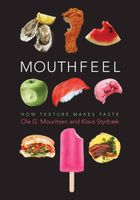Advertisement
Astringency
Appears in
By Ole Mouritsen and Klavs Styrbæk
Published 2017
Taste impression due to chemical reactions that lead to a mechanical sensory experience—that is, a type of mouthfeel that may be connected to the taste cells in the mouth. Known from the taste of tannic acid in tea or wine, which reacts with proteins containing proline in mucous and saliva. Leads to a biting, dry, rubbing feeling. Astringency can be experienced as either pleasant or unpleasant, depending on the context.
© 2017 All rights reserved. Published by Columbia University Press.



